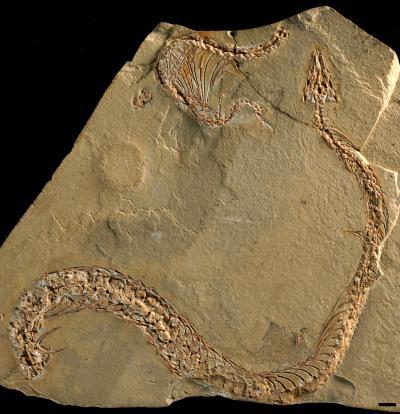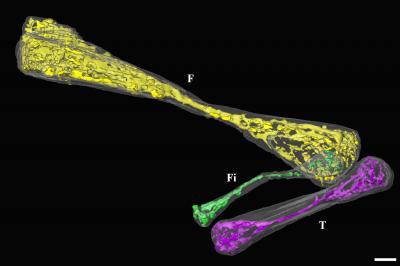New 3-D images in the Journal of Vertebrate Paleontology reveal that the internal architecture of an ancient snake's leg bones strongly resembles that of modern terrestrial lizard legs.
Only three specimens of fossilized snakes with preserved leg bones are in existence. Eupodophis descouensi, the ancient snake studied in this experiment, was discovered ten years ago in 95-million-year-old rocks in Lebanon. About 50 cm long overall, it exhibits a small leg, about 2 cm long, attached to the animal's pelvis. This fossil is key to understanding the evolution of snakes, as it represents an intermediate evolutionary stage when ancient snakes had not yet completely lost the legs they inherited from earlier lizards.

A photograph of Eupodophis descouensi, a fossil snake from the Cretaceous Period (95 million years ago) of Lebanon. The black scale bar at the bottom right equals 1 cm. Credit: A. Houssaye
Although the fossil exhibits just one leg on its surface, a second leg was thought to be concealed in the stone, and indeed this leg was revealed in full detail thanks to synchrotron X-rays.
The high-resolution 3-D images, in particular the fine detail of the buried small leg, suggest that this species lost its legs because they grew more slowly, or for a shorter period of time. The data also reveal that the hidden leg is bent at the knee and has four ankle bones but no foot or toe bones.

3-D reconstruction from synchrotron X-ray images of the previously hidden second leg of Eupodophis. The bones are artificially colored to highlight the internal structure of the bone and show how the snake's leg grew. Credit: A. Houssaye
"The revelation of the inner structure of Eupodophis hind limbs enables us to investigate the process of limb regression in snake evolution," says Alexandra Houssaye.
The scientists used synchrotron laminography, a recent imaging technique specially developed for studying large, flat samples. It is similar to the computed tomography (CT) technique used in many hospitals, but uses a coherent synchrotron X-ray beam to resolve details a few micrometers in size--some 1000 times smaller than a hospital CT scanner. For the new technique, the fossil is rotated at a tilted angle in a brilliant high-energy X-ray beam, with thousands of two-dimensional images recorded as it makes a full 360-degree turn. From these individual images, a high-resolution, 3-D representaton is reconstructed, which shows hidden details like the internal structures of the legs.
"Synchrotrons, these enormous machines, allow us to see microscopic details in fossils invisible to any other techniques without damage to these invaluable specimens," says Paul Tafforeau of the ESRF, a co-author of the study.





Comments